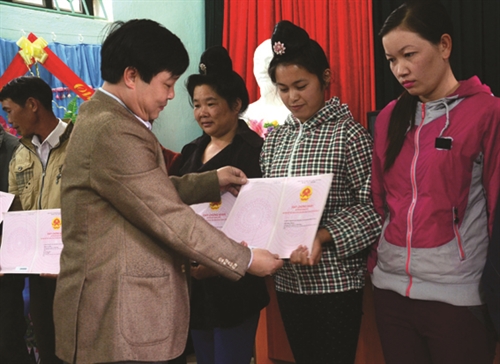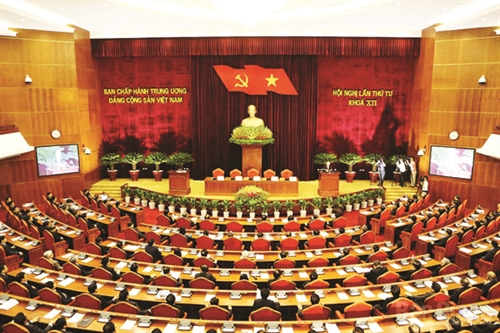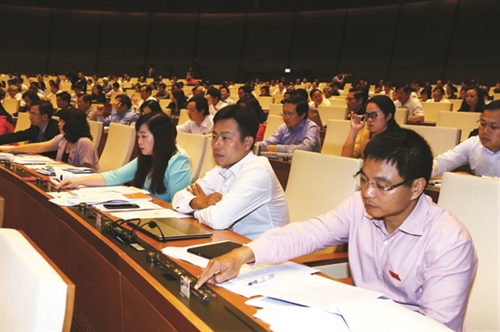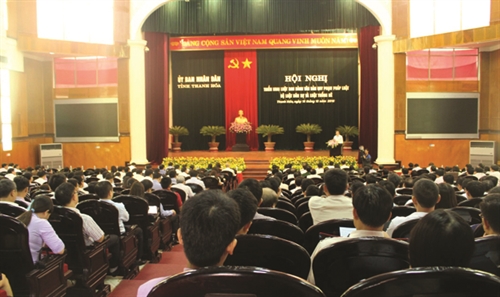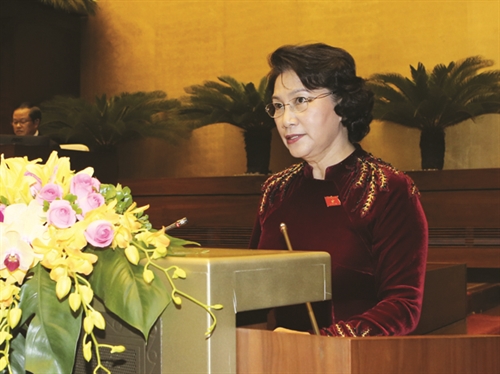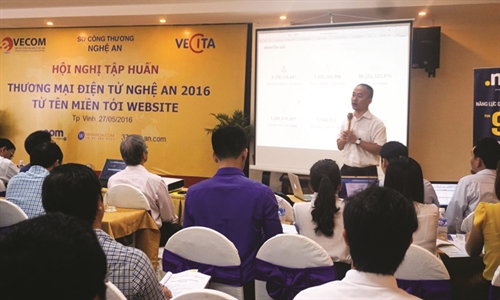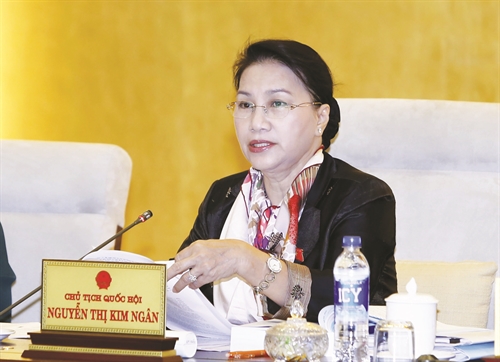 |
Tran Thanh Hai
Deputy Director-General
Agency of Foreign Trade
Ministry of Industry and Trade
Over the past 20 years, Viet Nam has step by step established and expanded its import and export markets and trade partners in the direction of diversifying and multilateralizing foreign trade ties. By now the country has trade relations with more than 200 countries and territories, and boasts a high trade-openness index (total trade accounting for more than 170% of GDP).
Export activities have not only made positive contributions to national economic growth but also created significant changes in domestic production and helped restructure the economy into a modern and industrialized one.
Imports have been used largely for improving the nation’s infrastructure, renewing production equipment and increasing production capacity, and attracting foreign direct investment projects.
In the 1995-2015 period, Vietnam’s import and export management policies have been incrementally adjusted in tune with the process of global economic integration and trade liberalization. The environment for import and export activities has markedly improved, making these activities important factors in the country’s economic growth.
However, these import and export management policies still reveal several shortcomings. There remains a lack of mechanisms to encourage the formation of a close link among raw material producers, processors and exporters so as to stabilize raw material sources and regulate exports so as to attain high export prices. Meanwhile, trade safeguards have not yet been effectively applied and technical standards and inspection requirements applicable to imports remain incomplete, leading to low effectiveness in the protection of domestic production and consumer interests in line with WTO’s regulations.
Against the backdrop of deep integration into the world economy, Vietnam needs to develop a new trade policy framework so as to boost export and reduce trade deficit.
Renewing import-export management
The most important solution that needs to be applied is to shape a new trade policy thinking.
Together with the process of trade liberalization and international economic integration, the economic and trade policy space is now undergoing great changes. The implementation of WTO commitments as well as bilateral and regional FTAs on the one hand generates an impulse for institutional reforms, thus helping the country adapt to and develop in the new situation. But on the other hand, it places restrictions on policy instruments which are designed to achieve such objectives as quickly restructuring the economy toward modernization, creating and tapping comparative advantages through policies.
Fortunately, the implementation of integration commitments does not narrow down the policy space for Vietnam to pursue its goals. The country’s objectives of developing supporting industries and spearhead industries and reducing trade deficit can be attained right on the path of integration, however, not by sticking to such measures as raising import duty or imposing import restrictions or bans but by applying more sophisticated, scientific and multi-sectoral policy instruments. Hence, institutions should be re-designed and improved in a way that facilitates the effective use of trade policy instruments.
There are five key principles that must be adhered to no matter how trade policy tools and institutions are devised.
Firstly, it is necessary to create a new synchronous and comprehensive trade policy framework. Because new-generation FTAs do not purely concern trade issues but relate to many other sectors such as investment, competition, intellectual property, environment, labor, etc., the to-be-built trade policy framework must be a combination of investment, competition and market regulation policies and other relevant policies. Such combination must be sophisticated enough to create institutions for administering international and regional economic integration roadmaps to seize every opportunity and effectively respond to every new challenge posed by global trade.
Secondly, the scope and content of trade policy should be renovated, aiming at dominating commodity lines and joining value chains rather than restricting itself to market penetration. In order to increase export value in a sustainable and systematic manner, there must be a strategy for participation in the global value and production and supply chains instead of unconnected ones. Meanwhile, import policy, which has been proven to be a driving force for technology renovation, human resources development and application of advanced management skills, should be directed at increasing domestic production capacity to meet both domestic and export demands.
Thirdly, institutional capacity should be built so as to design and implement lawful, subtle and scientific safeguard measures in conformity with our integration commitments. Reality shows that in the process of implementation of WTO or FTA commitments, non-tariff barriers are normally converted into tariff ones, while tariff barriers are adjusted to honor these commitments. However, research findings show that when the space for application of tariff measures shrinks, non-tariff measures will be used and become increasingly sophisticated. In order to effectively apply these measures, a systematic way of thinking and a multi-sectoral vision are needed. In fact, Vietnam, since its accession to the WTO, remains hesitant in putting up technical barriers against imports and the reason behind is limited capacity for designing and assessing the impacts of such barriers.
Fourthly, the new trade policy thinking should be designed following a consumer-centered approach as it is the only sustainably effective method, especially in the context when traditional safeguards are gradually lifted.
Lastly, the new trade policy should prioritize the formation of a number of strategic commodity-based association alliances to proactively regulate and adapt to abnormal changes in global prices. In addition, we should seek ways to join hands with top agricultural produce exporters so as to limit price fluctuations.
Viewpoints and orientations for import and export development
In the coming time, Vietnam will boost production to quickly increase export and satisfy domestic demand. Competitive edges of the economy will be properly tapped to increase the effectiveness and competitiveness of imports and exports, generate jobs and attain trade balance.
The country will also strengthen relations with its strategic partners to sustainably develop markets.
It will harmoniously combine immediate benefits with long-term interests and economic interests with political-foreign relation interests, and pursue the policy of proactiveness, independence and self-reliance in international economic integration.
In addition, import and export markets will be diversified. It is important for Vietnam to actively and proactively participate in the global production network and value chain while attaching importance to developing high added-value products with local and global brand names.
In light of this, export will be developed after the model of sustainable and reasonable growth along the line of increasing both the volume and added value of exports.
The structure of exports will be changed in a reasonable manner by quickly increasing the proportions of high added-value products, deep-processed products, hi-tech products and eco-friendly products.
Specifically, export of crude minerals will be gradually reduced according to a given roadmap while investments will be made to renew technology to increase the export of processed products.
For agricultural, forestry and fishery products, efforts will be made to increase their productivity, quality and added value, promoting the export of deep-processed products and products made with the aid of advanced technologies.
Attention will be paid to developing industrial products with a high content of technology and gray matter, promoting supporting industries, increasing the use of local materials and reduce dependence on imported raw and auxiliary materials.
In addition, appropriate policies will be adopted to encourage export of new commodity items which still have modest export value but show high growth potential.
Export markets will be diversified. The market shares of Vietnamese exports in traditional markets will be maintained and expanded while new potential export markets will be vigorously developed.
Along with promoting its role and position in international and regional organizations, Vietnam will increase economic diplomacy activities to expand export markets, develop trade promotion agencies in big and potential markets, and further protect Vietnamese goods and enterprises in the regional and global markets.
At the same time, the country will take advantage of opportunities brought about by the opening of foreign markets and tariff reduction roadmaps to boost export into the markets with which Vietnam has signed free trade agreements. It will also gradually build and develop overseas distribution networks for Vietnamese goods.
Vietnam will proactively adjust the growth of imports and concurrently develop supporting industries and boost the production of raw materials, fuel and auxiliary materials to serve export production as well as meet domestic demands.
It will strictly control the import of unnecessary commodities and diversify import markets in order to reduce trade deficit. The import of machinery, equipment and high technologies must match domestic resources and production levels while ensuring saving of energy and supplies.
Notably, the country will continue importing raw materials, fuels and supplies of which the local exploitation or production remains ineffective or causes adverse environmental impacts.
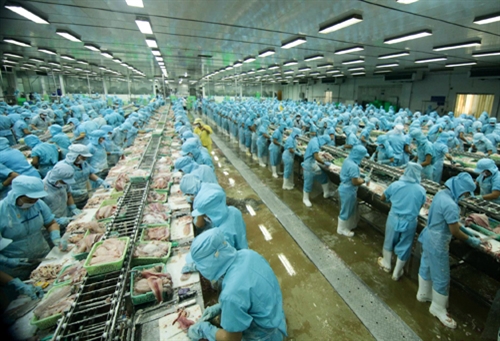 |
| Processing aquatic products at a company in Vam Cong industrial park (Dong Thap province) __Photo: Vu Sinh/VNA |
Policies to boost export and reduce trade gap
The State will make investment to develop supporting industries, increase the localization rates and added value of exports and gradually reduce the import of intermediate inputs. Foreign investment capital will be directed at export production and manufacturing and processing industries, especially those turning out high added-value products. Funds will also be invested to increase the capacity for production and processing of competitive exports, including products which constantly record a high export growth rate but still achieve small market shares. In addition, credit policies will be loosened to facilitate access to loans for producers and importers of raw materials used for export production and import duty on raw materials imported for production of agricultural, forestry and fishery products will be reduced.
The export management mechanism will be further improved. In the time to come, export standards will be introduced with a view to increasing the added value of exports while a schedule for restricting the export of unprocessed products will be drawn up. Moreover, authorities will impose requirements which enterprises must satisfy in order to export certain types of products as a measure to boost the link between raw material producers and exporters and develop processing and storage facilities.
Together with building capacity for forecasting supply and demand and prices in the world market, a mechanism for ensuring sustainable production and stable consumption of major farm products, such as rice, tra catfish, shrimp and coffee, will be put in place. Meanwhile, cooperation with other top exporters of farm products will be promoted to acquire information, exchange experience and regulate markets.
A strategy for attracting investment capital in the development of logistic services will be devised, aiming at cutting logistic costs to improve the effectiveness of import and export activities.
Last but not least, cross-border trade will be strictly managed, particularly for high-value and large-volume products.
In order to reduce trade deficit, a reasonable trade protection policy framework and mechanism will be built, taking into consideration the application of a wide range of tariff and trade defense measures to protect farm products and competitive industrial products.
In addition, a raft of solutions will be implemented. They include administering exchange rates in a flexible manner to support export and control import; reviewing and analyzing the lists of imports in order to work out proper management measures; setting up technical barriers and applying food hygiene and safety standards to imports; implementing a national program of action on production of import substitutes; boosting domestic trade promotion activities; improving bidding regulations toward prioritizing the use of domestically available goods and services; reviewing the grant of the right to distribute consumer goods to foreign-invested enterprises; and stepping up the fight against smuggling, counterfeit goods and trade frauds.-

